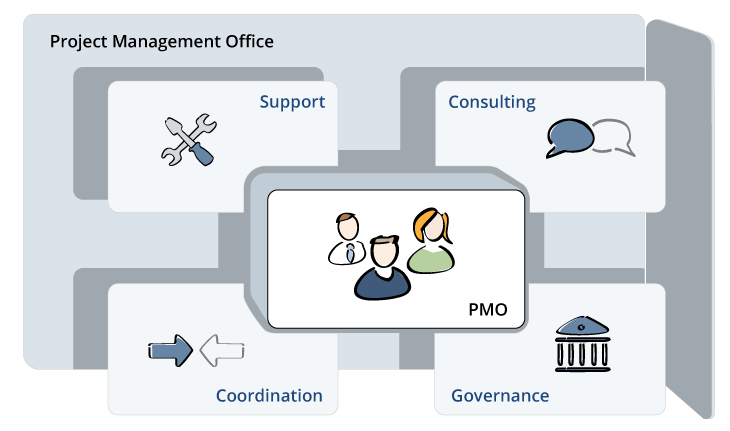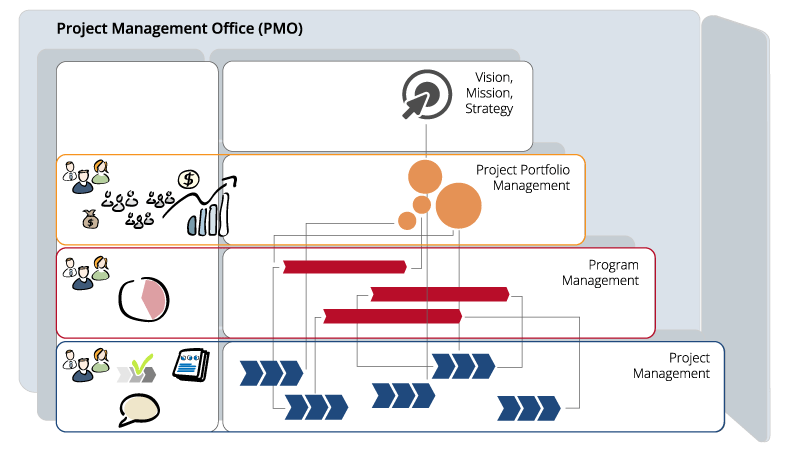The Project Management Office (PMO)
What happens in the Project Management Office (PMO)? Why does it improve Multi-Project Management and how?

The PMO supports all project participants with documentation, guidelines, templates and tools.
The PMO is available to all project participants with advice and support when it comes to methods, training and coaching.
The PMO coordinates resources, costs and deadlines across projects, if necessary.
The PMO provides a management framework within which project decisions are made.
Definition according to the 7th Edition of PMI’s 2021 PMBOK Guide.
PMO is a project management structure that standardizes project-related management processes and supports the distribution of resources, methodologies, tools and methods.
Competencies of the PMO According to PMBOK
According to the Project Management Body of Knowledge (PMBOK) des Project Management Institute (PMI®) PMOs support the delivery of value through projects by
- fostering delivery and results-oriented skills,
- maintaining an overview,
- organizing continuous improvement, knowledge transfer, and change management.
With the acceleration of markets, PMOs are also tasked with evaluating and ensuring actual value creation and benefit realization. They are responsible for
- aligning with critical initiatives,
- implementing smart and simple processes,
- empowering people and capabilities,
- affirming and empowering a culture of change.
Definition according to DIN 69901-5 Project Management – Project Management Systems
The PMO has a “cross-project support function to implement and optimize project management systems and provide operational support to projects and project stakeholders.”
What Is the Position of the PMO?
A PMO can exist at the portfolio, program, or project level.
Project Portfolio Management Offices (PPMO) can also exist for departments or business units. PPMOs are staffed with employees who have knowledge of Project Portfolio Management and a focus on maximizing value creation. They evaluate business cases to start projects, allocate budgets and resources, and are responsible for central management and controlling.
There can also be PMOs at the program management level, for which the abbreviation PrgMO is occasionally found. Programs consist of several projects with a common program goal. Since programs are time-limited, a Program Management Office operates for the duration of the respective program.
For a limited perios of time, a Project Office (PO) is also active. A PO is only responsible for one project and exists for the duration of the project. It relieves the project manager, provides analyses, reports, KPIs and documentation at project level. A PMO can contain the tasks of a project office, but is also responsible for continuous improvement processes across projects.
As all project management standard works are increasingly oriented towards agile methods and focus on value development, the current PMBOK Guide suggests the use of a Value Delivery Office (VDO). Similar to an Agile Center of Excellence (ACoE) a VDO has no central management or oversight role, but focuses on coaching project teams, building adaptive capabilities, and mentoring sponsors and product owners to respond more quickly to their feedback. VDOs take the approach of helping to shape the corporate culture.

PMO Tasks
Multi-Project Management of Resources, Deadlines and Costs
Cross-Project Quality and Risk Management
Establish compliance through audits, reviews, and quality assurance or standards compliance measures.
Business Case Orientation
Make the organization’s mission and vision clear to all project staff and prioritize, initiate and evaluate projects based on this.
Portfolio Management
PMOs, who help make strategic executive decisions, assemble project portfolios, collect and deliver KPIs on portfolio value growth, and monitor them.
Establishment of Project Management Processes, Methods and Tools
Introduce and use procedures based on best practices (e.g. PRINCE2, PMBOK, Scrum, SAFe, etc.) and support them with appropriate tools.
Training and Coaching
Encourage and develop employee skills to understand and properly apply methods.
Knowledge Management
Enable learning from each other and sharing knowledge, e.g., through lessons learned, wikis, guides, documentation, and direct internal communication (face-to-face meetings and workshops).
Stakeholder Management and Customer Satisfaction
Customer satisfaction is the decisive criterion for successful projects. For this reason, a PMO in its overarching position must always help to obtain feedback, develop formats for stakeholder analyses and communication, i.e., align project management overall with the customer focus.
Project Management in Practice
Test our PMO software objectiF RPM 30 days free of charge »
Agile PMO
What does a PMO have to deliver in times of VUCA ? Can there be an agile PMO at all, or is the centralized top-down approach of the classic PMO not in total contrast to agile basic principles? No matter how agile a PMO is today, it must promote adaptability to constant change, strengthen customer focus and encourage project staff to act responsibly. Real-time, cross-project change management is required if you want to respond quickly to customer feedback. The value of the results counts.
An agile PMO therefore has much less of a control or management function than a classic one. It is much more of an agile coach and advisor for self-managed teams. Like agile guilds or communities of practice, its goal is a cross-project exchange of best practices and an improvement in the quality of work. Its motto might be: Prescribe less, infer more, and recommend.
An agile project management office cannot be a separate department that you knock on to get staff, money or time deferrals. It must be a “servant-leader” that actively supports, promotes and provides the teams with important information. To ensure that the overall goal, the vision, is never lost, the agile PMO takes care of feedback from stakeholders and potential customers. It defines and finances so-called value streams. For this purpose, it evaluates the value creation of the portfolio on a higher level.
These are the tasks of an agile PMO
- to continuously improve processes (Kaizen)
- drive shared value creation (Lean Portfolio Management)
- support, coach, promote self-managed teams (like a Scrum Master)
- centralize results (with software)
As the COVID-19 pandemic outbreak has also brought profound changes to project management, and collaboration has often taken place remotely, PMOs have been given additional responsibilities such as implementing effective communication and collaboration tools, accelerating digital transformation through technological advancements, developing remote leadership, and centralized crisis management.
